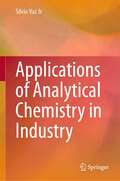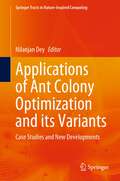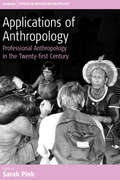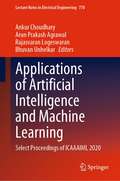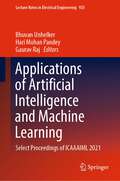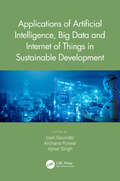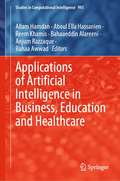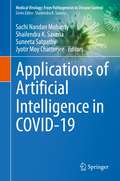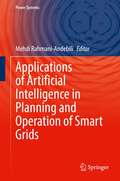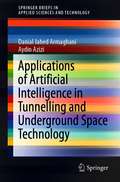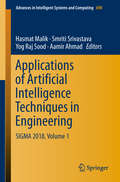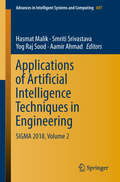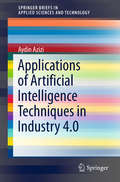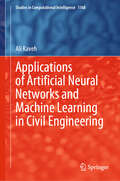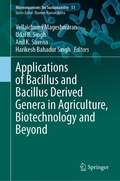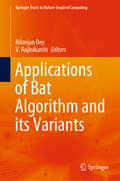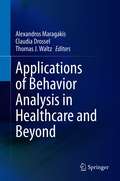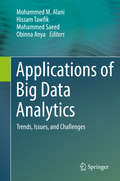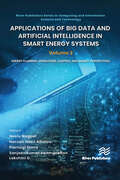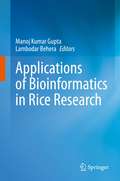- Table View
- List View
Applications of Analytical Chemistry in Industry
by Silvio Vaz JrThis book deals with analytical techniques and methods applied in several sectors of technology and industry and serves as a concise and up-to-date reference for the practical application of analytical chemistry. Divided into 10 chapters, the book starts with an introduction to the fundamentals of analytical chemistry, followed by a review of modern analytical technologies and their application in different industrial sectors and activities such as agrochemicals and pharmaceuticals, ores and mining, polymers, biotechnology, and oil & gas. Particular attention is given to industrial environmental issues, where the author discusses the advanced analytical techniques used to provide quantitative information about pollutants in aqueous and gaseous effluents and their carbon footprint. The book finishes with a chapter summarizing the main remarks and conclusions on advanced analytical techniques used in different industrial sectors, as well as on topics of sustainability, and instrumental analysis. In this book, readers will find valuable insights, including real-life examples, of how classical and instrumental techniques can be used by industry, to help professionals in the quality control of raw materials, products and processes, in the assessment of the formulation contamination, environmental pollution and in the evaluation of sustainability, among others. Given its breadth, the book appeals to professionals (mainly chemists, biochemists, and engineers), researchers, professors, and graduate students.
Applications of Ant Colony Optimization and its Variants: Case Studies and New Developments (Springer Tracts in Nature-Inspired Computing)
by Nilanjan DeyThis book explains the basic ideas behind several variants of ant colony optimization (ACO) and shows how they may be used in real-world settings like manufacturing, engineering design, and health care. Marco Dorigo proposed ACO for the first time, and it has been used to solve a variety of optimization problems. This book presents the latest developments of ACO.
Applications Of Anthropology
by Sarah PinkAt the beginning of the twenty-first century the demand for anthropological approaches, understandings and methodologies outside academic departments is shifting and changing. Through a series of fascinating case studies of anthropologists' experiences of working with very diverse organizations in the private and public sector this volume examines existing and historical debates about applied anthropology. It explores the relationship between the "pure and the impure" - academic and applied anthropology, the question of anthropological identities in new working environments, new methodologies appropriate to these contexts, the skills needed by anthropologists working in applied contexts where multidisciplinary work is often undertaken, issues of ethics and responsibility, and how anthropology is perceived from the 'outside'. The volume signifies an encouraging future both for the application of anthropology outside academic departments and for the new generation of anthropologists who might be involved in these developments.
Applications of Artificial Intelligence (AI) and Machine Learning (ML) in the Petroleum Industry
by Manan Shah Ameya Kshirsagar Jainam PanchalToday, raw data on any industry is widely available. With the help of artificial intelligence (AI) and machine learning (ML), this data can be used to gain meaningful insights. In addition, as data is the new raw material for today’s world, AI and ML will be applied in every industrial sector. Industry 4.0 mainly focuses on the automation of things. From that perspective, the oil and gas industry is one of the largest industries in terms of economy and energy. Applications of Artificial Intelligence (AI) and Machine Learning (ML) in the Petroleum Industry analyzes the use of AI and ML in the oil and gas industry across all three sectors, namely upstream, midstream, and downstream. It covers every aspect of the petroleum industry as related to the application of AI and ML, ranging from exploration, data management, extraction, processing, real-time data analysis, monitoring, cloud-based connectivity system, and conditions analysis, to the final delivery of the product to the end customer, while taking into account the incorporation of the safety measures for a better operation and the efficient and effective execution of operations. This book explores the variety of applications that can be integrated to support the existing petroleum and adjacent sectors to solve industry problems. It will serve as a useful guide for professionals working in the petroleum industry, industrial engineers, AI and ML experts and researchers, as well as students.
Applications of Artificial Intelligence and Machine Learning: Select Proceedings of ICAAAIML 2020 (Lecture Notes in Electrical Engineering #778)
by Ankur Choudhary Arun Prakash Agrawal Rajasvaran Logeswaran Bhuvan UnhelkarThe book presents a collection of peer-reviewed articles from the International Conference on Advances and Applications of Artificial Intelligence and Machine Learning - ICAAAIML 2020. The book covers research in artificial intelligence, machine learning, and deep learning applications in healthcare, agriculture, business, and security. This volume contains research papers from academicians, researchers as well as students. There are also papers on core concepts of computer networks, intelligent system design and deployment, real-time systems, wireless sensor networks, sensors and sensor nodes, software engineering, and image processing. This book will be a valuable resource for students, academics, and practitioners in the industry working on AI applications.
Applications of Artificial Intelligence and Machine Learning: Select Proceedings of ICAAAIML 2021 (Lecture Notes in Electrical Engineering #925)
by Bhuvan Unhelker Hari Mohan Pandey Gaurav RajThe book presents a collection of peer-reviewed articles from the International Conference on Advances and Applications of Artificial Intelligence and Machine Learning—ICAAAIML 2021. The book covers research in the areas of artificial intelligence, machine learning, and deep learning applications in health care, agriculture, business, and security. This book contains research papers from academicians, researchers as well as students. There are also papers on core concepts of computer networks, intelligent system design and deployment, real-time systems, wireless sensor networks, sensors and sensor nodes, software engineering, and image processing. This book is a valuable resource for students, academics, and practitioners in the industry working on AI applications.
Applications of Artificial Intelligence and Neural Systems to Data Science (Smart Innovation, Systems and Technologies #360)
by Anna Esposito Marcos Faundez-Zanuy Francesco Carlo Morabito Eros PaseroThis book provides an overview on the current progresses in artificial intelligence and neural nets in data science. The book is reporting on intelligent algorithms and applications modeling, prediction, and recognition tasks and many other application areas supporting complex multimodal systems to enhance and improve human–machine or human–human interactions. This field is broadly addressed by the scientific communities and has a strong commercial impact since investigates on the theoretical frameworks supporting the implementation of sophisticated computational intelligence tools. Such tools will support multidisciplinary aspects of data mining and data processing characterizing appropriate system reactions to human-machine interactional exchanges in interactive scenarios. The emotional issue has recently gained increasing attention for such complex systems due to its relevance in helping in the most common human tasks (like cognitive processes, perception, learning, communication, and even "rational" decision-making) and therefore improving the quality of life of the end users.
Applications of Artificial Intelligence, Big Data and Internet of Things in Sustainable Development
by Sam Goundar Archana Purwar Ajmer SinghThis book focuses on different algorithms and models related to AI, big data and IoT used for various domains. It enables the reader to have a broader and deeper understanding of several perspectives regarding the dynamics, challenges, and opportunities for sustainable development using artificial intelligence, big data and IoT. Applications of Artificial Intelligence, Big Data and Internet of Things (IoT) in Sustainable Development focuses on IT-based advancements in multidisciplinary fields such as healthcare, finance, bioinformatics, industrial automation, and environmental science. The authors discuss the key issues of security, management, and the realization of possible solutions to hurdles in sustainable development. The reader will master basic concepts and deep insights of various algorithms and models for various applications such as healthcare, finance, education, smart cities, smart cars, among others. Finally, the book will also examine the applications and implementation of big data IoT, AI strategies to facilitate the sustainable development goals set by the United Nations by 2030. This book is intended to help researchers, academics, and policymakers to analyze the challenges and future aspects for maintaining sustainable development through IoT, big data, and AI.
Applications of Artificial Intelligence in Business, Education and Healthcare (Studies in Computational Intelligence #954)
by Aboul Ella Hassanien Allam Hamdan Anjum Razzaque Bahaaeddin Alareeni Reem Khamis Bahaa AwwadThis book focuses on the implementation of Artificial Intelligence in Business, Education and Healthcare, It includes research articles and expository papers on the applications of Artificial Intelligence on Decision Making, Entrepreneurship, Social Media, Healthcare, Education, Public Sector, FinTech, and RegTech. It also discusses the role of Artificial Intelligence in the current COVID-19 pandemic, in the health sector, education, and others. It also discusses the impact of Artificial Intelligence on decision-making in vital sectors of the economy.
Applications of Artificial Intelligence in COVID-19 (Medical Virology: From Pathogenesis to Disease Control)
by Sachi Nandan Mohanty Shailendra K. Saxena Suneeta Satpathy Jyotir Moy ChatterjeeThe book examines the role of artificial intelligence during the COVID-19 pandemic, including its application in i) early warnings and alerts, ii) tracking and prediction, iii) data dashboards, iv) diagnosis and prognosis, v) treatments, and cures, and vi) social control. It explores the use of artificial intelligence in the context of population screening and assessing infection risks, and presents mathematical models for epidemic prediction of COVID-19. Furthermore, the book discusses artificial intelligence-mediated diagnosis, and how machine learning can help in the development of drugs to treat the disease. Lastly, it analyzes various artificial intelligence-based models to improve the critical care of COVID-19 patients.
Applications of Artificial Intelligence in Engineering: Proceedings of First Global Conference on Artificial Intelligence and Applications (GCAIA 2020) (Algorithms for Intelligent Systems)
by Xiao-Zhi Gao Rajesh Kumar Sumit Srivastava Bhanu Pratap SoniThis book presents best selected papers presented at the First Global Conference on Artificial Intelligence and Applications (GCAIA 2020), organized by the University of Engineering & Management, Jaipur, India, during 8–10 September 2020. The proceeding will be targeting the current research works in the domain of intelligent systems and artificial intelligence.
Applications of Artificial Intelligence in Planning and Operation of Smart Grids (Power Systems)
by Mehdi Rahmani-AndebiliArtificial intelligence (AI) is going to play a significant role in smart grid planning and operation, especially in solving its real-time problems, as it is fast, adaptive, robust, and less dependent on the system’s accurate model and parameters. This collection covers research advancements in the application of AI in the planning and operation of smart grids. A global group of researchers and scholars present innovative approaches to AI-based smart grid planning and operation, cover the theoretical concepts and experimental results of the application of AI-based techniques, and apply these techniques to deal with smart grid issues. Applications of Artificial Intelligence in Planning and Operation of Smart Grids is an ideal resource for researchers on the theory and application of AI, practicing engineers working in electrical power engineering, and students in advanced graduate-level courses.
Applications of Artificial Intelligence in Tunnelling and Underground Space Technology (SpringerBriefs in Applied Sciences and Technology)
by Aydin Azizi Danial Jahed ArmaghaniThis book covers the tunnel boring machine (TBM) performance classifications, empirical models, statistical and intelligent-based techniques which have been applied and introduced by the researchers in this field. In addition, a critical review of the available TBM performance predictive models will be discussed in details. Then, this book introduces several predictive models i.e., statistical and intelligent techniques which are applicable, powerful and easy to implement, in estimating TBM performance parameters. The introduced models are accurate enough and they can be used for prediction of TBM performance in practice before designing TBMs.
Applications of Artificial Intelligence Techniques in Engineering: Sigma 2018, Volume 2 (Advances In Intelligent Systems and Computing #697)
by Aamir Ahmad Yog Raj Sood Smriti Srivastava Hasmat MalikThe book is a collection of high-quality, peer-reviewed innovative research papers from the International Conference on Signals, Machines and Automation (SIGMA 2018) held at Netaji Subhas Institute of Technology (NSIT), Delhi, India. The conference offered researchers from academic and industry the opportunity to present their original work and exchange ideas, information, techniques and applications in the field of computational intelligence, artificial intelligence and machine intelligence. The book is divided into two volumes discussing a wide variety of industrial, engineering and scientific applications of the emerging techniques.
Applications of Artificial Intelligence Techniques in Engineering: SIGMA 2018, Volume 2 (Advances in Intelligent Systems and Computing #697)
by Hasmat Malik Smriti Srivastava Yog Raj Sood Aamir AhmadThe book is a collection of high-quality, peer-reviewed innovative research papers from the International Conference on Signals, Machines and Automation (SIGMA 2018) held at Netaji Subhas Institute of Technology (NSIT), Delhi, India. The conference offered researchers from academic and industry the opportunity to present their original work and exchange ideas, information, techniques and applications in the field of computational intelligence, artificial intelligence and machine intelligence. The book is divided into two volumes discussing a wide variety of industrial, engineering and scientific applications of the emerging techniques.
Applications of Artificial Intelligence Techniques in Industry 4.0 (SpringerBriefs in Applied Sciences and Technology)
by Aydin AziziThis book is to presents and evaluates a way of modelling and optimizing nonlinear RFID Network Planning (RNP) problems using artificial intelligence techniques. It uses Artificial Neural Network models (ANN) to bind together the computational artificial intelligence algorithm with knowledge representation an efficient artificial intelligence paradigm to model and optimize RFID networks.This effort leads to proposing a novel artificial intelligence algorithm which has been named hybrid artificial intelligence optimization technique to perform optimization of RNP as a hard learning problem. This hybrid optimization technique consists of two different optimization phases. First phase is optimizing RNP by Redundant Antenna Elimination (RAE) algorithm and the second phase which completes RNP optimization process is Ring Probabilistic Logic Neural Networks (RPLNN). The hybrid paradigm is explored using a flexible manufacturing system (FMS) and the results are compared with well-known evolutionary optimization technique namely Genetic Algorithm (GA) to demonstrate the feasibility of the proposed architecture successfully.
Applications of Artificial Neural Networks and Machine Learning in Civil Engineering (Studies in Computational Intelligence #1168)
by Ali KavehThis book provides different applications of artificial neural networks (ANN) and machine learning (ML) in various problems of material science, structural optimization, and optimal analysis of structures in twenty two chapters. Nowadays, the world has witnessed unprecedented advances in technology and computer science. Artificial intelligence has emerged as a top field captivating global attention. Often referred to as AI, this technology stands apart from other disciplines as it aims to design machines and systems that exhibit intelligence, learn autonomously, and make decisions akin to humans. In order to comprehend the impact of this innovation, one must delve into the workings of artificial intelligence, trace its historical evolution from inception to the present day, and explore its diverse applications in domains like medicine, transportation, broadcasting, and marketing. Artificial intelligence introduces a transformative element to our reality, fostering significant breakthroughs and innovations. The book is used in any AI course, in particular, in Civil Engineering. It is also utilized in various fields of Industrial Civil Engineering.
Applications of Bacillus and Bacillus Derived Genera in Agriculture, Biotechnology and Beyond (Microorganisms for Sustainability #51)
by Vellaichamy Mageshwaran Udai B. Singh Anil K. Saxena Harikesh Bahadur SinghThis edited volume provides a comprehensive view of the recent developments on Bacillus and their application in agriculture and allied sectors in a global scenario. Research articles sharing a consolidated state-of-the-art development in this area are solicited for this book. This book is a complete package covering all spheres of diversity and taxonomy, nutrient supplementation, biotic and abiotic stress management, biofilm and endophytic colonization, commercialization and regulatory mechanisms, etc. Descriptions of cutting-edge techniques and novel approaches on Bacillus research is also covered. A part of the book concentrates on the biotic and abiotic stress management in several important crops. It contains 11 contributory chapters from eminent experts in the field of life sciences specially microbiology, plant pathology and biotechnology working on different aspects of Bacilli and their application in agriculture and allied sectors. This book is useful for Graduate, Post-graduate students, research scholars, and post doctorate scholars of plant science, plant microbiology, soil microbiology and plant pathology discipline researchers, academicians, industrialists, policy makers.
Applications of Bat Algorithm and its Variants (Springer Tracts in Nature-Inspired Computing)
by Nilanjan Dey V. RajinikanthThis book highlights essential concepts in connection with the traditional bat algorithm and its recent variants, as well as its application to find optimal solutions for a variety of real-world engineering and medical problems. Today, swarm intelligence-based meta-heuristic algorithms are extensively being used to address a wide range of real-world optimization problems due to their adaptability and robustness. Developed in 2009, the bat algorithm (BA) is one of the most successful swarm intelligence procedures, and has been used to tackle optimization tasks for more than a decade. The BA’s mathematical model is quite straightforward and easy to understand and enhance, compared to other swarm approaches. Hence, it has attracted the attention of researchers who are working to find optimal solutions in a diverse range of domains, such as N-dimensional numerical optimization, constrained/unconstrained optimization and linear/nonlinear optimization problems. Along with the traditional BA, its enhanced versions are now also being used to solve optimization problems in science, engineering and medical applications around the globe.
Applications of Behavior Analysis in Healthcare and Beyond
by Alexandros Maragakis Claudia Drossel Thomas J. WaltzThis timely volume explores the multiple domains where Behavior Analysts can provide meaningful assessment and interventions. Selecting clinical areas in which behavior analysts already are active, chapters will describe unique features of the setting as well as the skills and competencies needed to practice in these areas. While providers of behavior analytic services have substantially increased in number, the field of behavior analysis itself has narrowed. Reimbursement policies and name recognition as a treatment specific to autism have raised concerns that other areas where it is helpful, such as behavioral gerontology or integrated behavioral health, will be de-emphasized. This volume aims to promote workforce development and support broad behavior analytic training, considering the Behavior Analyst Certification Board’s 5th edition task list (effective in 2020).
Applications of Big Data Analytics: Trends, Issues, and Challenges
by Mohammed M. Alani Hissam Tawfik Mohammed Saeed Obinna AnyaThis timely text/reference reviews the state of the art of big data analytics, with a particular focus on practical applications. An authoritative selection of leading international researchers present detailed analyses of existing trends for storing and analyzing big data, together with valuable insights into the challenges inherent in current approaches and systems. This is further supported by real-world examples drawn from a broad range of application areas, including healthcare, education, and disaster management. The text also covers, typically from an application-oriented perspective, advances in data science in such areas as big data collection, searching, analysis, and knowledge discovery.Topics and features:Discusses a model for data traffic aggregation in 5G cellular networks, and a novel scheme for resource allocation in 5G networks with network slicingExplores methods that use big data in the assessment of flood risks, and apply neural networks techniques to monitor the safety of nuclear power plantsDescribes a system which leverages big data analytics and the Internet of Things in the application of drones to aid victims in disaster scenariosProposes a novel deep learning-based health data analytics application for sleep apnea detection, and a novel pathway for diagnostic models of headache disordersReviews techniques for educational data mining and learning analytics, and introduces a scalable MapReduce graph partitioning approach for high degree verticesPresents a multivariate and dynamic data representation model for the visualization of healthcare data, and big data analytics methods for software reliability assessmentThis practically-focused volume is an invaluable resource for all researchers, academics, data scientists and business professionals involved in the planning, designing, and implementation of big data analytics projects.Dr. Mohammed M. Alani is an Associate Professor in Computer Engineering and currently is the Provost at Al Khawarizmi International College, Abu Dhabi, UAE. Dr. Hissam Tawfik is a Professor of Computer Science in the School of Computing, Creative Technologies & Engineering at Leeds Beckett University, UK. Dr. Mohammed Saeed is a Professor in Computing and currently is the Vice President for Academic Affairs and Research at the University of Modern Sciences, Dubai, UAE. Dr. Obinna Anya is a Research Staff Member at IBM Research – Almaden, San Jose, CA, USA.
Applications of Big Data and Artificial Intelligence in Smart Energy Systems: Volume 1 Smart Energy System: Design and its State-of-The Art Technologies (River Publishers Series in Computing and Information Science and Technology)
by Neelu Nagpal Hassan Haes Alhelou Pierluigi Siano Sanjeevikumar Padmanaban D. LakshmiIn the era of propelling traditional energy systems to evolve towards smart energy systems, including power generation, energy storage systems, and electricity consumption have become more dynamic. The quality and reliability of power supply are impacted by the sporadic and rising use of electric vehicles, domestic loads, and industrial loads. Similarly, with the integration of solid state devices, renewable sources, and distributed generation, power generation processes are evolving in a variety of ways. Several cutting-edge technologies are necessary for the safe and secure operation of power systems in such a dynamic setting, including load distribution, automation, energy regulation & control, and energy trading. This book covers the applications of various big data analytics,artificial intelligence, and machine learning technologies in smart grids for demand prediction, decision-making processes, policy, and energy management. The book delves into the new technologies for modern power systems such as the Internet of Things, Blockchain for smart home and smart city solutions in depth. Technical topics discussed in the book include: • Hybrid smart energy system technologies • Smart meters • Energy demand forecasting • Use of different protocols and communication in smart energy systems • Power quality and allied issues and mitigation using AI • Intelligent transportation • Virtual power plants • AI based smart energy business models • Smart home solutions • Blockchain solutions for smart grids.
Applications of Big Data and Artificial Intelligence in Smart Energy Systems: Volume 2 Energy Planning, Operations, Control and Market Perspectives (River Publishers Series in Computing and Information Science and Technology)
by Neelu Nagpal Hassan Haes Alhelou Pierluigi Siano Sanjeevikumar Padmanaban D. LakshmiIn the era of propelling traditional energy systems to evolve towards smart energy systems, including power generation, energy storage systems, and electricity consumption have become more dynamic. The quality and reliability of power supply are impacted by the sporadic and rising use of electric vehicles, and domestic & industrial loads. Similarly, with the integration of solid state devices, renewable sources, and distributed generation, power generation processes are evolving in a variety of ways. Several cutting-edge technologies are necessary for the safe and secure operation of power systems in such a dynamic setting, including load distribution automation, energy regulation and control, and energy trading. This book covers the applications of various big data analytics, artificial intelligence, and machine learning technologies in smart grids for demand prediction, decision-making processes, policy, and energy management. The book delves into the new technologies such as the Internet of Things, blockchain, etc. for smart home solutions, and smart city solutions in depth in the context of the modern power systems. Technical topics discussed in the book include: • Hybrid smart energy system technologies • Energy demand forecasting • Use of different protocols and communication in smart energy systems • Power quality and allied issues and mitigation using AI • Intelligent transportation • Virtual power plants • AI business models.
Applications of Bioinformatics in Rice Research
by Manoj Kumar Gupta Lambodar BeheraThis book summarizes the advanced computational methods for mapping high-density linkages and quantitative trait loci in the rice genome. It also discusses the tools for analyzing metabolomics, identifying complex polyploidy genomes, and decoding the extrachromosomal genome in rice.Further, the book highlights the application of CRISPR-Cas technology and methods for understanding the evolutionary development and the de novo evolution of genes in rice.Lastly, it discusses the role of artificial intelligence and machine learning in rice research and computational tools to analyze plant-pathogen co-evolution in rice crops.
Applications of Biomedical Engineering in Dentistry
by Lobat TayebiThis book offers readers a valuable overview of recent advances in biomedical engineering, as applied to the modern dentistry. It begins by studying the biomaterials in dentistry, and materials used intraoperatively during oral and maxillofacial surgery procedures. Next, it considers the subjects in which biomedical engineers can be influential, such as 3-dimensional (3D) imaging, laser and photobiomodulation, surface modification of dental implants, and bioreactors. Hard and soft tissue engineerings in dentistry are discussed, and some specific and essential methods such as 3D-printing are elaborated. Presenting particular clinical functions of regenerative dentistry and tissue engineering in treatment of oral and maxillofacial soft tissues is the subject of a separate chapter. Challenges in the rehabilitation handling of large and localized oral and maxillofacial defects is a severe issue in dentistry, which are considered to understand how bioengineers help with treatment methods in this regard. Recent advances in nanodentistry is discussed followed by a chapter on the applications of stem cell-encapsulated hydrogel in dentistry.Periodontal regeneration is a challenging issue in dentistry, and thus, is going to be considered separately to understand the efforts and achievements of tissue engineers in this matter. Oral mucosa grafting is a practical approach in engineering and treatment of tissues in ophthalmology, which is the subject of another chapter. Microfluidic approaches became more popular in biomedical engineering during the last decade; hence, one chapter focuses on the advanced topic of microfluidics technologies using oral factors as saliva-based studies. Injectable gels in endodontics is a new theme in dentistry that bioengineering skills can advance its development, specifically by producing clinically safe and effective gels with regeneration and antibacterial properties. Engineered products often need to be tested in vivo before being clinical in dentistry; thus, one chapter is dedicated to reviewing applicable animal models in dental research. The last chapter covers the progress on the whole tooth bioengineering as a valuable and ultimate goal of many dental researchers.Offers readers an interdisciplinary approach that relates biomedical engineering and restorative dentistryDiscusses recent technological achievements in engineering with applications in dentistryProvides useful tool to dental companies for future product planning, specifically to biomedical engineers engaged in dental research
